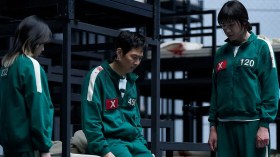Two verses of ‘One Art’, a poem by American wordsmith Elizabeth Bishop, mark the beginning of the biographical account of her time in Brazil, waxing lyrical about loss and life. ‘The art of losing isn’t hard to master; so many things seem really to be meant to be lost that their loss is no disaster,’ she opines, the poem’s choice as the introduction to Bruno Barreto’s feature is purposeful and pointed. The tale that follows is one, of course, of coming to terms with the ephemera of existence.
Seeking a cure to writer’s block in 1951, Bishop (Miranda Otto, I, Frankenstein) travels past Rio de Janeiro to stay with her college friend, Mary (Tracy Middendorf, TV’s Boardwalk Empire), at the home of architect Lota de Macedo Soares (Glória Pires, Brazilian serial Insensato Coração), the visitor and the host getting off to a rocky start. Illness prolongs Bishop’s trip, and hostilities slowly turn to romantic affection despite their opposing demeanors; however their personal differences and paths through alcoholism and depression – not to mention the nation’s unstable political climate – continues to cause further complications over the course of sixteen years.
Adapting the best-selling book Rare and Commonplace Flowers by Carmem Lucia de Oliveira, Reaching for the Moon charts a cycle of continual change for its central couple in which the endurance of love remains the only constant. Director Barreto (Last Stop 174) and writers Matthew Chapman (The Ledge) and Julie Sayres (Hope Island) take the stately approach to Bishop’s story, de Oliveira’s work, and Carolina Kotscho’s (Breaking the Taboo) earlier incarnation of the screenplay on which the film is also based, outward in the embrace of the romance, though restrained in evoking anything but cursory emotions.
Instead, the feature is left to hang on the importance of its characters and the accompanying performances, the former poised as ever-so-interesting, the latter playing as ever-so-refined. There’s more than a kernel in truth in the way each is presented, for Bishop and Soares are undeniably figures of intrigue for their achievements, and Otto and Pires turn in fitting portrayals of composure and flamboyance respectively; alas, there’s also nothing more than the rendering of each in the most standard fashion. Like the muted tones that flavour the film’s images and the stolid framing that lacks flair, everything is constrained and drained of colour. Dialogue that sounds directly read off the page doesn’t help matters, nor does the over-use of visual suggestiveness – tasteful, of course – or scenes that take the material’s meaning much too literally.
What results is fuelled by good intentions of honouring its protagonist and her paramour, not to mention abundant with gracious period details, but ultimately eked out with simplicity and melodrama in mind. When ‘One Art’ surfaces again as the obvious bookend at the end of the film, it merely completes the paint-by-numbers compilation that the feature can never escape. For the film itself, the loss of spirit isn’t as easily overcome as Bishop’s prose endeavours to intimate otherwise.
Rating: 2 out of 5 stars
Reaching for the Moon
Director: Bruno Barreto
Brazil, 2013, 118 mins
Release date: July 17
Distributor: Leap Frog Films
Rated: M
Actors:
Director:
Format:
Country:
Release:





